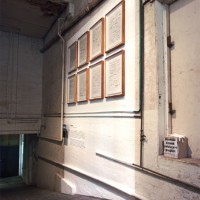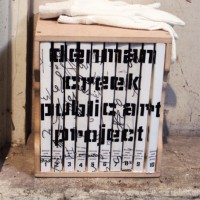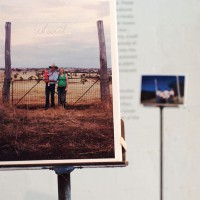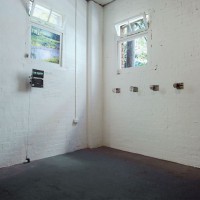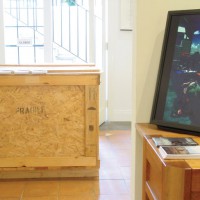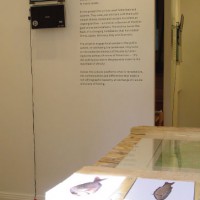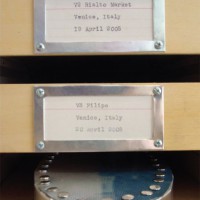Public Art and Alternative Tactics in Post-Acquisitive Society
Part 1 – Rural
Part 2 – Urban
Materials:
Mixed and multi media.
Concept:
This exhibition explores new art practices in the public realm, projects that embrace sustainable practice and challenge the perception of value within a predominantly capitalist freemarket economy. They call for a broadening of the definition of the perceived work of artists that embraces the eudemonic potential of creative thinking as well as an understanding of aesthetics. This exhibition is presented in two sections ‘Rural’ & ‘Urban’ across two locations Helen Rose Schauersberg Labratorium, Surry Hills and Palmer Street Gallery, Darlinghurst respectively.
The purpose of the exhibition ‘Public Art and Alternative Tactics in Post-Acquisitive Society’ was to provide an overview of seven major research projects that were undertaken during Flanagan’s doctoral research candidature. Each project was originally designed to function site-specifically and these elements cannot be adequately conveyed through documentation. Every dynamic is changed when a work conceived for outdoor space, sound and interaction is placed in a gallery context.
Invitation concept:
Mapping is important to locate the projects and navigate the diversity of the exhibition and so a map was conceived depicting the location of the Australian projects. Like drawing a map in the sand, Flanagan worked with Ramon Grendene to draw a map of New South Wales with coloured chalk on an urban street in Newcastle and photographed the action every ten seconds over two days. The photos were then edited into a time lapse sequence, with soundtrack by independent artists the ‘Pentatones’, which became a digital invitation. A still shot from the end of the film, of the finished map was printed on A3 soft matt paper and folded in the fashion of a road map – an invitation to the exhibition and a link to the web-site.
The individual projects are documented elsewhere on this site so the focus here is on their presentation in the exhibition space.
Part 1 – Rural
presents the outcomes of five projects completed in partnership with four regional and remote communities in New South Wales; Merriwa, (RMB 2329, Merriwa Public Art Project); Denman, (Denman Creek Interpretative Signage Walk) and (Hyde Park Public Art Project); Singleton, (Hunter River Sculpture); and Gloucester, (Ten Thousand Steps Interpretative Sculpture Walk).
To curate the exhibition, the artist attempted to convey a sense of scale and material, and locate the objects in the landscape by conveying the distances involved in reaching them. The invitation for the exhibition ‘Public Art and Alternative Tactics in Post- Acquisitive Society’ and exhibition design for ‘Rural’ was produced in collaboration with the graphic designer Ramon Grendene (Switzerland).
The location for the exhibition Rural was in the heart of Sydney in Surry Hills on the second floor of a warehouse that was formerly used as police stables. This historic site features a ramp, engraved by years of use under horse’s hooves, running from the back of a ground floor garage up to the first floor main gallery. Visitors enter from the bright daylight of the street, into the dimly lit garage, where light is visible at the back wall. Traversing the garage to the bottom of the horse ramp, the light is emanating from a video work that is playing. The introductory video is an image, split into three horizontal bands. Each horizontal band is created from three moving images collaged together to forms a landscape panorama. All four bands show a moving panorama of Newcastle headland, the images spin slowly around to view the beach and the harbour and the lighthouse and back to the beach until they all start moving down the road. All the images are filmed at different times of the year. The four bands show the journey out of Newcastle to the locations of the public art works in the exhibition. The time lapse compresses the three hour journey to the furthest location into six minutes. All four panoramas feature the same landscape until one of the four panoramas changes direction and starts heading north over a bridge and onward into the country side. Eventually another one of the panoramas turns in another direction. Then another, which abruptly stops and focuses on a public artwork it has stopped in front of. Meanwhile the other images are still travelling onward through the vast rural countryside, one environment is now dry grazing pasture, while another is lush, green forest. All the driving sequences finally arrive at the locations of the artworks featured in the exhibition.
Walking up the steep ramp a large wall text explains the concept behind the research. The walls of the ramp and the landing feature objects and images from the Denman projects.
Each project is explained in a wall text and a video work alongside sculptural elements. Each video begins with one of the panorama films driving to the location and then runs through a slide show of the resulting public artwork on location.
Part 2 – Urban
The projects presented in this exhibition document local urban public art projects, one based in the Newcastle suburb of Mayfield (Harmony Day Mural) and the other a collection of stories from urban communities around the world: Newcastle in Australia, Weimar in Germany, Venice in Italy, (Preserved Fish). In different ways they illuminate diversity, migration, immigration and map the local in relation to international networks.
The exhibition space is a traditional white gallery space located in the ground floor of a terrace house in the Sydney inner city suburb of Paddington. A large wooden shipping crate sits in the centre of the exhibition space stamped with a multi lingual sign ‘Preserved Fish’. On the top of the box, under glass, is a historic map of Newcastle Harbour and around it a series of free postcards featuring fish on one side and a fish recipe on the other. The recipes are from all over the world, a collection of the favourite dishes of the fisherpersons the artists met. It is the fisherpersons voices that can be heard when exploring three wooden boxes that sit on old tables, Formica topped with steel legs and peeling paint, reminiscent of the fish market. Opening the drawers of these boxes activates a story, a fisherperson’s yarn. The voices speak in Italian, German and Australian English.
The walls of the gallery feature a historic collection of nautical maps, featuring all of the countries the artists visited. The maps are oceanographic depicting, not the nations themselves, but the oceans between them. Countries are abstractly recognisable in their negative, reduced to a boundary line on the perimeters of vast areas of ocean. The connections between places are visually mapped through the shipping lanes and topographic undulations.
Project partners:
- Ramon Grendene
- The University of Newcastle
Exhibitions:
- Public Art and Alternative Tactics in Post-Acquisitive Society, Part Two: Urban, Palmer Street Ga.llery, Darlinghurst Australia, Jan 2009
- Public Art and Alternative Tactics in Post-Acquisitive Society, Part One: Rural, Hellen Rose Schaumberger Labratorium, Surry Hills Australia. Dec 2008
Multi Media:
- http://triciaflanagan.com/ Accessed 2nd Oct 2009.
- http://www.youarewatchingus.com/ Accessed 2nd Oct 2009
Thanks:
- Ramon Grendene
- Charnelle Mondy
- Anne Graham
- Tony Bond
- Micheal Cohen
- Kit Messham-Muir
- Rowena Foong
- Heather Taylor
- Emma Champion
- Ian Taylor
- Adam Taylor
- Funding support from
The University of Newcastle.


